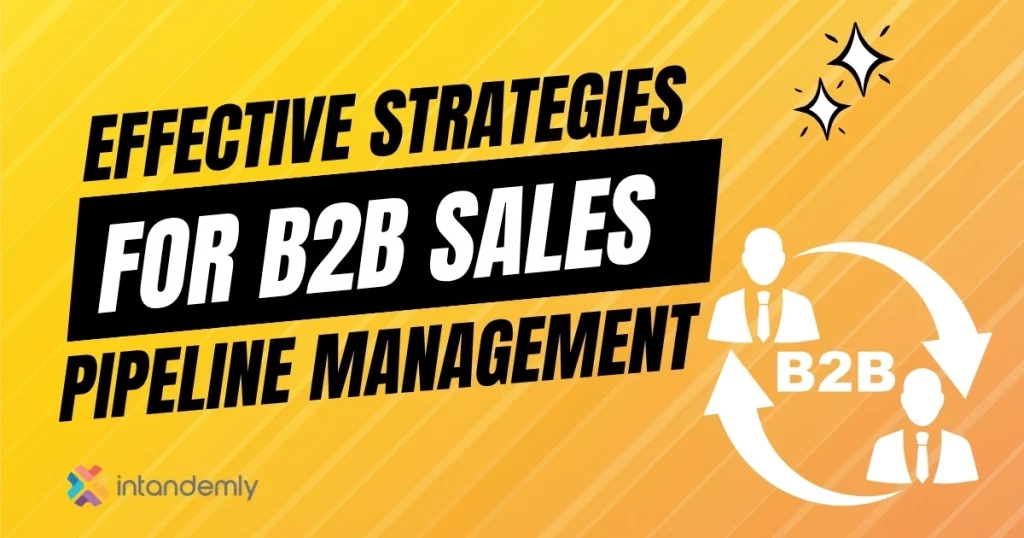
Sales pipeline management is the backbone of B2B revenue success. It provides visibility into the sales process, helps forecast accurately, and ensures consistent deal flow. However, many businesses struggle with cluttered pipelines, inconsistent follow-ups, and lack of clarity on deal stages.
Forecasting Accuracy: Helps predict revenue and allocate resources.
Sales Team Accountability: Offers visibility into rep performance.
Process Optimization: Identifies bottlenecks and drop-off points.
Prospecting
Qualification
Needs Analysis
Proposal/Presentation
Negotiation
Closing
Each stage must have:
Specific entry/exit conditions
Required documentation or buyer actions
Assigned owner and deadline
Sales stages should reflect how buyers make decisions. This ensures reps are engaging with the right messaging at the right time.
Tools like Salesforce, HubSpot, and Pipedrive can:
Visualize pipeline stages
Track activities and outcomes
Forecast revenue and conversion rates
Conduct weekly pipeline reviews with sales reps
Use these sessions for coaching and strategy refinement
Remove dead leads or stale opportunities
Use scoring systems to prioritize deals based on:
Revenue potential
Sales velocity
Fit with ICP (Ideal Customer Profile)
AI-driven platforms can:
Score leads based on behavior
Recommend next steps
Detect stalled deals or early warning signs
An overstuffed pipeline dilutes focus. Remove:
Inactive leads beyond a certain timeframe
Low-intent accounts
Deals with poor engagement
Consistency in follow-up builds trust and keeps deals moving. Use:
Email sequences
Scheduled calls
Personalized content
Marketing can support pipeline velocity by:
Providing lead nurturing content
Running account-based campaigns
Sharing buyer behavior data
Win rate
Average deal size
Sales cycle length
Pipeline coverage ratio
Relying solely on gut feeling
Not updating CRM data
Skipping stages or rushing to close
A mid-market SaaS firm cut their sales cycle by 25% by:
Defining clear qualification criteria
Automating follow-up reminders
Holding bi-weekly sales coaching sessions
A healthy pipeline is an active pipeline. By implementing structured processes, leveraging technology, and aligning with the buyer journey, B2B sales leaders can optimize performance and drive consistent growth. Pipeline management isn’t just about tracking deals—it’s about creating momentum and ensuring nothing slips through the cracks.
-competitive B2B landscape, LinkedIn has emerged as a powerhouse for lead generation, networking, and business development. With over 1 billion users globally—many of whom are decision-makers—LinkedIn offers a golden opportunity for targeted outreach. However, sending random connection requests and generic messages won’t yield meaningful results. To truly boost B2B engagement, businesses need a strategic and personalized approach.
Professional Audience: LinkedIn users are more business-focused, making it easier to connect with relevant professionals.
Advanced Targeting: Filters based on role, industry, company size, and location allow for highly tailored outreach.
Content & Thought Leadership: Sharing insightful posts enhances credibility and keeps you top-of-mind with prospects.
Your profile is your first impression. A poorly optimized profile can drive away potential leads.
Professional Headshot: Builds trust instantly.
Headline With Value Proposition: Go beyond job titles—mention the problems you solve.
Optimized Summary: Include keywords, experience, and a call-to-action.
Featured Section: Showcase thought leadership content, case studies, or testimonials.
Start with LinkedIn Sales Navigator or the basic search function:
Use filters like job title, industry, and location.
Target second-degree connections for a warmer outreach.
Build prospect lists around events, industry news, or product launches.
Avoid default templates. Customization increases acceptance rates significantly.
Mention a shared connection or mutual interest.
Reference their content or company news.
Keep it under 300 characters and be respectful of their time.
Successful outreach doesn’t end with a connection. It’s about nurturing a conversation.
Message 1 (After Connection): A thank-you note without a pitch.
Message 2: Share a valuable insight, article, or case study.
Message 3: Ask a question to engage.
Message 4: Make a soft pitch only after trust is built.
Posting consistently increases visibility and builds authority.
Share industry insights, trends, or behind-the-scenes posts.
Use native documents or carousels to boost engagement.
Engage with your target audience’s posts meaningfully.
Best days: Tuesday–Thursday
Best times: 8–10 AM and 4–6 PM (prospect’s local time)
Frequency: Don’t spam—space messages 3–5 days apart
Tools like Expandi, Zopto, and Waalaxy can scale outreach—but misuse can get your account restricted.
Always personalize the first message.
Test copy with small groups before scaling.
Respect daily limits to avoid red flags.
Just like email marketing, test different subject lines, CTAs, and formats.
Track response rates and engagement levels.
Refine based on data, not assumptions.
Connection acceptance rate
Response rate to first message
Number of qualified leads generated
Engagement on your posts
LinkedIn outreach isn’t about shortcuts—it’s about strategy, personalization, and patience. By optimizing your profile, crafting authentic messages, and engaging consistently with relevant content, you’ll transform cold connections into warm conversations that drive real B2B results.
Now’s the time to stop blending in and start building genuine relationships that convert. The opportunity on LinkedIn is massive—if you know how to leverage it right.
Intandemly helps B2B companies identify, engage, and convert high-value accounts with a powerful blend of AI precision and human expertise.
©2025. All Rights Reserved.